We may not have the course you’re looking for. If you enquire or give us a call on +1 7204454674 and speak to our training experts, we may still be able to help with your training requirements.
Training Outcomes Within Your Budget!
We ensure quality, budget-alignment, and timely delivery by our expert instructors.
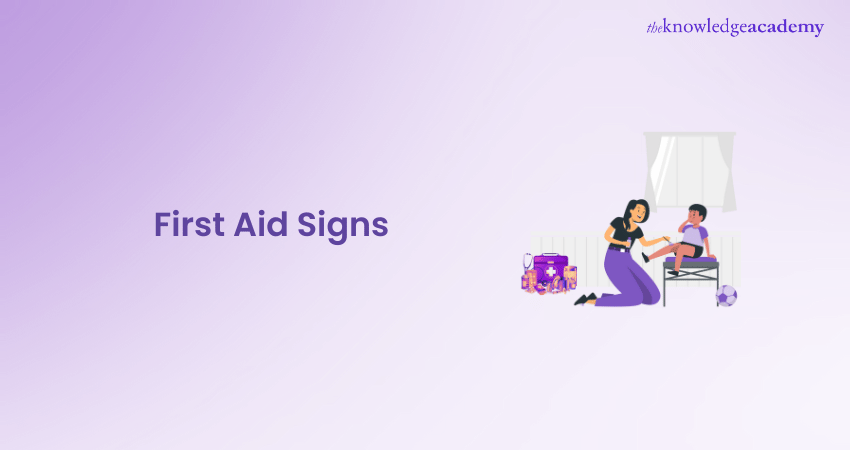
You might have come across this saying often - “every second counts”. So, knowing your First Aid Signs can be as crucial as the life-saving skills themselves. These unassuming icons play a crucial role in emergency preparedness and response. They guide people to safety and care.
Imagine a bustling crowd, and suddenly someone collapses. Your eyes scan the chaos, seeking that familiar white cross—the beacon of hope. It’s not just an icon; it’s a lifeline. But what makes theseFirst Aid Signs so vital? They’re the universal language of emergency aid, guiding us to safety and care when every second counts.
Table of Contents
1) Why is First Aid Important?
2) First Aid: A Historical Overview
3) Importance of First Aid Symbol
4) Various First Aid Symbols and Signs
5) Conclusion
Why is First Aid Important?
First Aid is an important skill. It has the power to alter a life-or-death situation. Every year, countless lives are lost in incidents where proper First Aid could have been the difference between life and death.
According to the British Red Cross, it is rather surprising to realise that a mere 5% of adults in the UK know to act in emergencies. It involves severe bleeding or when someone is unresponsive. This indicates that most adults might miss the chance to save a life because of a lack of First Aid knowledge.
Understanding First Aid is not complex. There are excellent First Aid courses available that are uncomplicated and filled with crucial information that can save lives. However, the true value of this knowledge is only realised when individuals have the confidence to apply their First Aid skills when they matter most.
First Aid: A Historical Overview
First Aid, although lacking a single pinpointed birth, has a rich history of care for the injured and ill. Its origins can be traced back to ancient times when assistance was provided, particularly notable in Egyptian history with their proficiency in bandaging techniques. From there, it continued to evolve:
1) Greek Adoption: The Greeks were quick to adopt bandaging techniques from the Egyptians, which is evident in their pottery depictions of these methods.
2) Roman Pioneers: The Roman Army played a pivotal role in advancing First Aid. They established field hospitals, complete with ambulances and skilled surgeons, during battles.
3) French Innovation: Baron Dominique Jean Larrey, a French surgeon and military doctor, created the first ambulance corps during the French Revolution and Napoleonic Wars. His corps, equipped with supplies, carriages, stretchers, and a team of Field Surgeons, revolutionised wartime medical care.
4) British Adaptation: The British, renowned for their adaptability, embraced the French innovations. Major Peter Shepherd, a British surgeon, played a crucial role in this transition. He not only taught life-saving First Aid techniques to British Army personnel but also extended his knowledge to the public. His public lectures in Woolwich, South East London, marked a significant shift by taking First Aid training beyond the battlefield and into the public domain.
Importance of First Aid Symbol
First Aid Symbols play a vital role in emergency preparedness and response. They serve as universal visual cues that convey the availability of immediate medical assistance and supplies. Understanding the importance of First Aid and its symbols is essential, as they can make a significant difference in various ways:
1) Rapid Identification: In high-stress situations, every second counts. First Aid Symbols provide quick and clear identification of the nearest sources of medical aid, reducing response time and potentially saving lives.
2) Universal Recognition: The simplicity and widespread use of First Aid Symbols ensure that people from diverse cultures and backgrounds can understand them. This universal recognition is crucial in our interconnected and multicultural world.
3) Cultural Sensitivity: First Aid Symbols are designed to accommodate cultural and religious sensitivities. Variations such as the Red Crescent and Red Crystal ensure that the symbols are acceptable and respected in different regions and communities.
4) Peace of Mind: With the First Aid Symbol at nearby, it is a comforting thought. It creates confidence within people that aid is there in case of any emergencies. A general sense of safety and well-being is enhanced because of it.
5) Global Cooperation: Though First Aid Symbols is merely an icon, it is one of the international efforts aimed at helping people. Symbols, such as those represented by the Red Cross and National Red Crescent Societies, are used by these agencies during emergencies and conflicts to go past political borders and conflict boundaries.
Indeed, apart from being signs, First Aid Symbols are symbols used for communication, safety, and assisting humanity. They are a connection between language and culture, giving an assurance of hopes in case of disaster and an advancement of good rescue system. This knowledge and the recognition of these, are two basic steps to be optimal in handling medical emergencies.
Elevate your understanding of Fire Safety principles and practices today with our Fire Safety Training – Sign up now!
Various First Aid Symbols and Signs
In the world of First Aid, symbols and signs are irreplaceable tools that communicate essential messages instantly and universally. These symbols range from simple and obvious aids to hidden and coded ones, ensuring that life can be preserved, and assistance provided in any situation. Additionally, these symbols play a crucial role in educating everyone about the aims of First Aid. Let's explore some of the various First Aid symbols and signs:
1) The AED Sign for First Aid
An Automated External Defibrillator or AED is a device used to overcome an arrhythmia or abnormal heart rhythm during a cardiac emergency. Often, the AED sign is a colour-coded stand-alone icon that directs people to this indispensable device. These automatic external defibrillators are typically placed in public spaces.
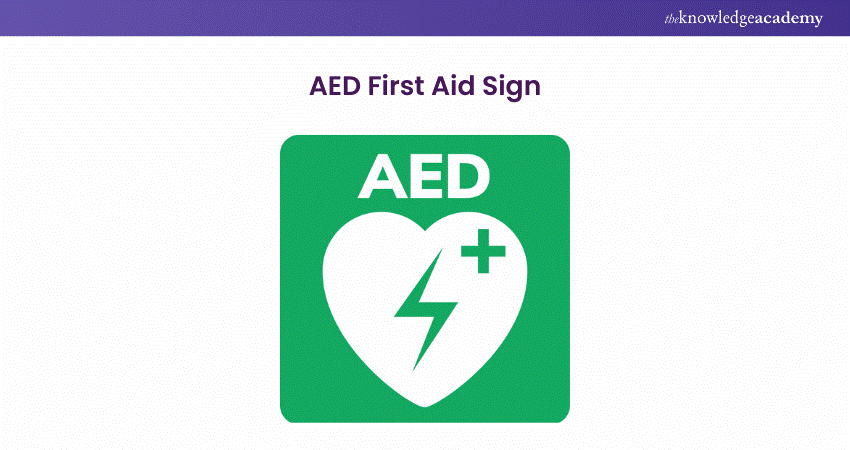
2) The Green Cross (ISO Standard)
Recognised internationally, the green cross symbolises locations where you can find First Aid assistance, pharmacies, and First Aid facilities. Its ubiquity helps individuals identify the availability of medical aid, promoting a sense of security.
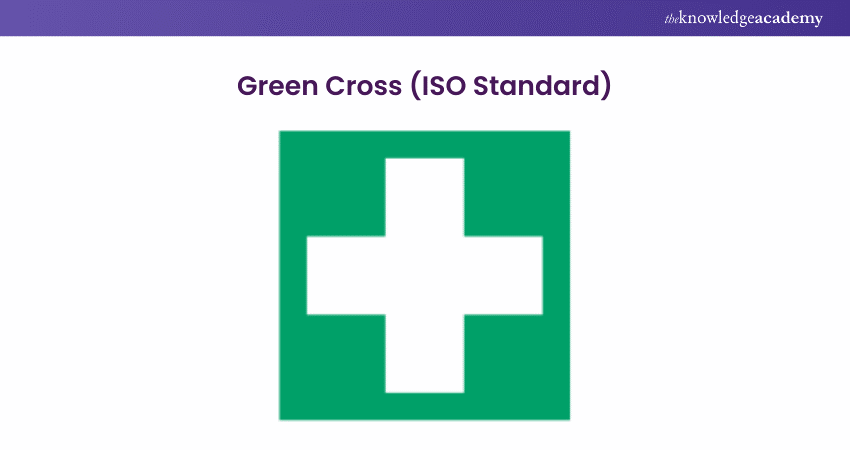
3) Symbols of the Red Cross, Crescent, and Crystal
The Red Cross, Red Crescent, and Red Crystal symbols, respectively, are internationally known and highly accepted. They embody impunity and humanitarian assistance in moments of crisis, which underlines the priority of conducting unbiased care for all during crises.
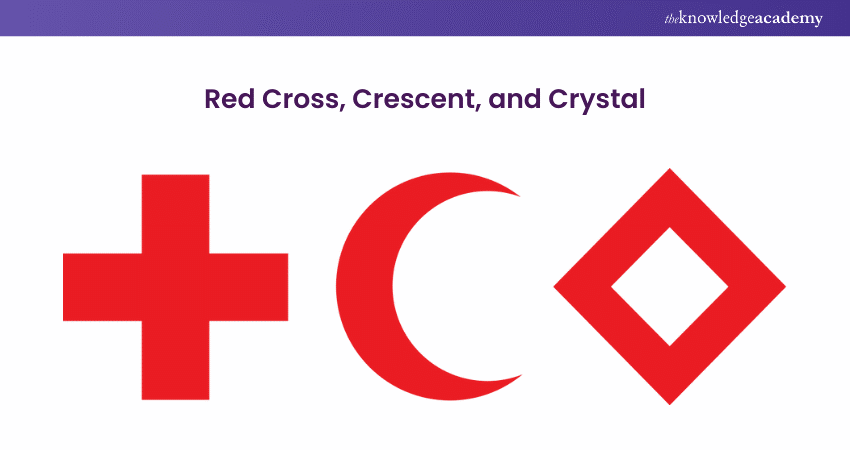
4) Depicting Asclepius and the Caduceus
Ancient symbols of medicine, Asclepius's staff and the Caduceus continue to influence modern healthcare. They serve as reminders of the enduring commitment to healing and the medical profession's enduring heritage.
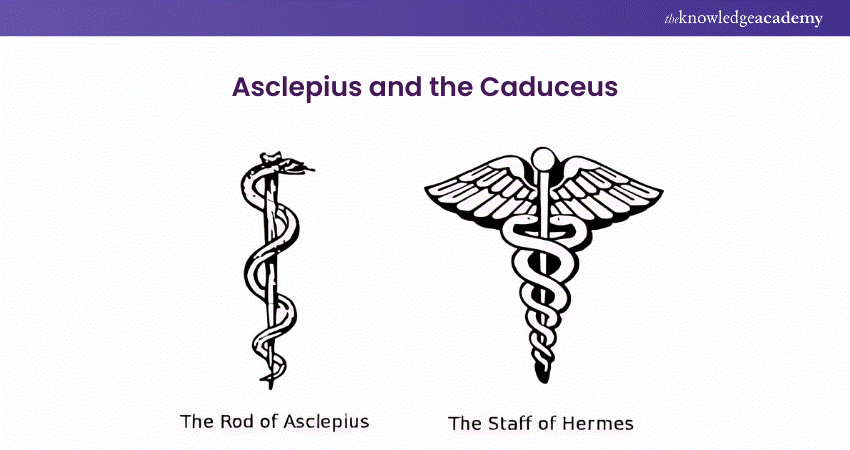
Each of these symbols and signs contributes to the overall landscape of First Aid, ensuring that individuals can readily identify and access medical assistance when it matters most. Understanding these symbols makes us better prepared to respond effectively to medical emergencies.
Ensure safety in your workplace with our First Aid at Work Training – Sign up today!
Conclusion
We hope you read and understand everything about First Aid Signs. These symbols bridge language barriers and guide us toward the right actions when someone’s health is at stake. Whether it’s the red cross indicating medical help or the lightning bolt for defibrillators, each symbol carries a life-saving message. So, let’s keep these icons close to heart—because in those critical moments, every second truly counts!
Create a safer and healthier workplace with our Health & Safety in the Workplace Courses – Sign up now!
Frequently Asked Questions

Generally, the essentials of first aid embrace assessing the situation, ensuring both the safety of the rescuer and the injured person, contacting emergency help if it is needed, doing the initial treatment for life-threatening symptoms (CPR or wound treatment usually) and monitoring the individual patient until professional help arrives.

The universal symbol for aid is the red cross, a bold red cross on a white background. It represents medical care, assistance, and neutrality in conflicts. Adopted by the Red Cross Movement, it’s widely recognised as a symbol of help and protection. Variants like the red crescent and red crystal are also used in different regions.

The Knowledge Academy takes global learning to new heights, offering over 30,000 online courses across 490+ locations in 220 countries. This expansive reach ensures accessibility and convenience for learners worldwide.
Alongside our diverse Online Course Catalogue, encompassing 17 major categories, we go the extra mile by providing a plethora of free educational Online Resources like News updates, Blogs, videos, webinars, and interview questions. Tailoring learning experiences further, professionals can maximise value with customisable Course Bundles of TKA.

The Knowledge Academy’s Knowledge Pass, a prepaid voucher, adds another layer of flexibility, allowing course bookings over a 12-month period. Join us on a journey where education knows no bounds.

The Knowledge Academy offers various Health & Safety in the Workplace, including First Aid at Work Course, Manual Handling at Work Course and Health and Safety Training for Managers and Supervisors Course. These courses cater to different skill levels, providing comprehensive insights into knowing the Workplace Health and Safety.
Our Health & Safety Blogs covers a range of topics offering valuable resources, best practices, and industry insights. Whether you are a beginner or looking to advance your Business Improvement skills, The Knowledge Academy's diverse courses and informative blogs have you covered.
Upcoming Health & Safety Resources Batches & Dates
Date
 First Aid at Work
First Aid at Work
Fri 17th Jan 2025
Fri 21st Feb 2025
Fri 4th Apr 2025
Fri 6th Jun 2025
Fri 25th Jul 2025
Fri 7th Nov 2025
Fri 26th Dec 2025







 Top Rated Course
Top Rated Course



 If you wish to make any changes to your course, please
If you wish to make any changes to your course, please


